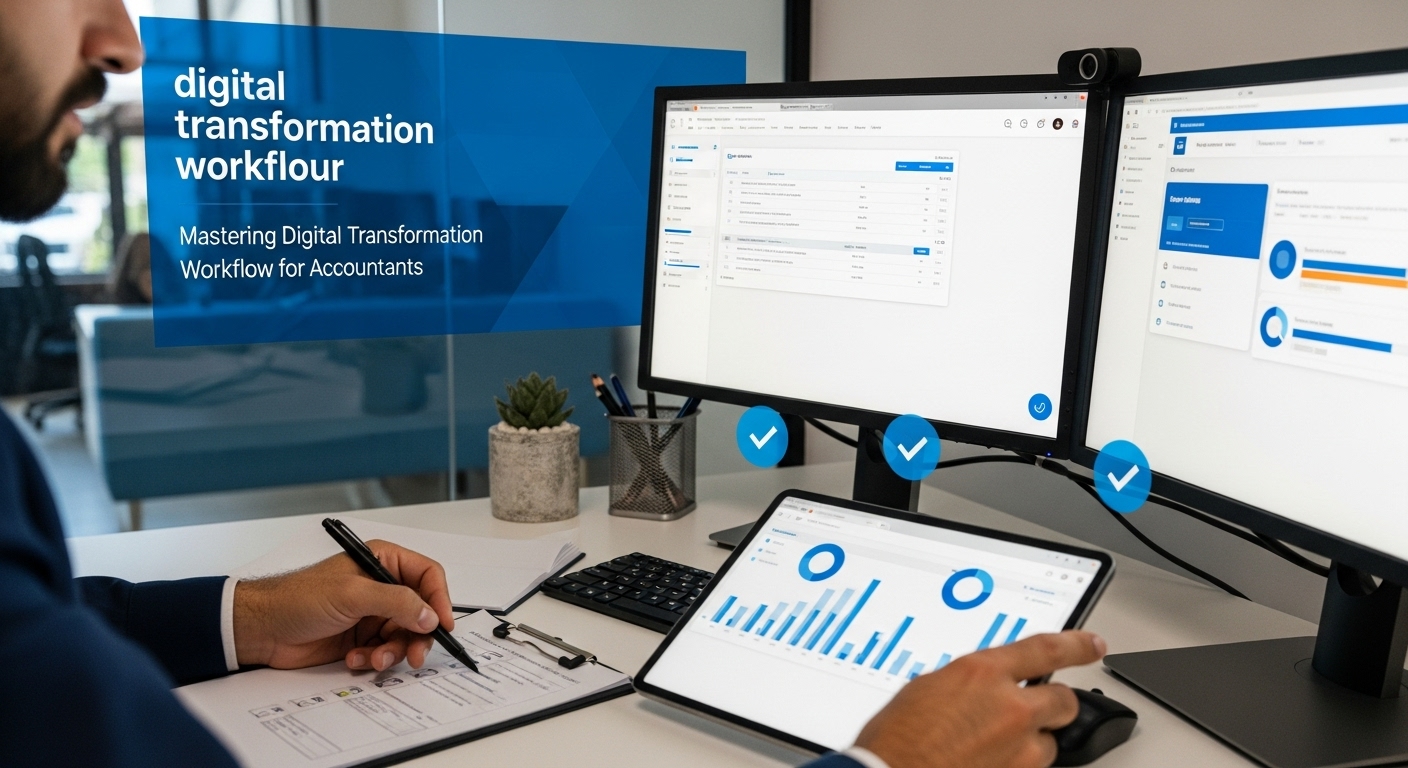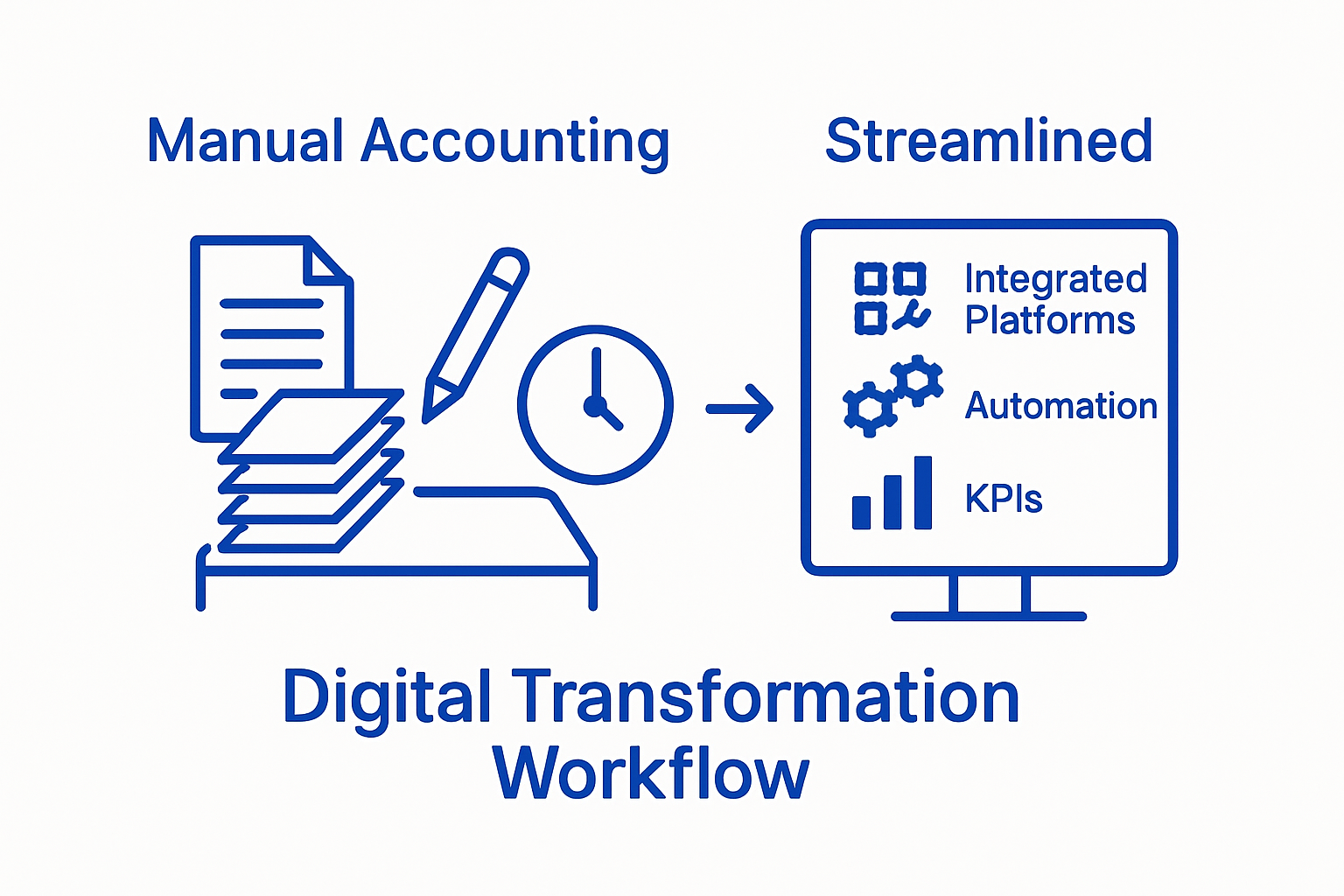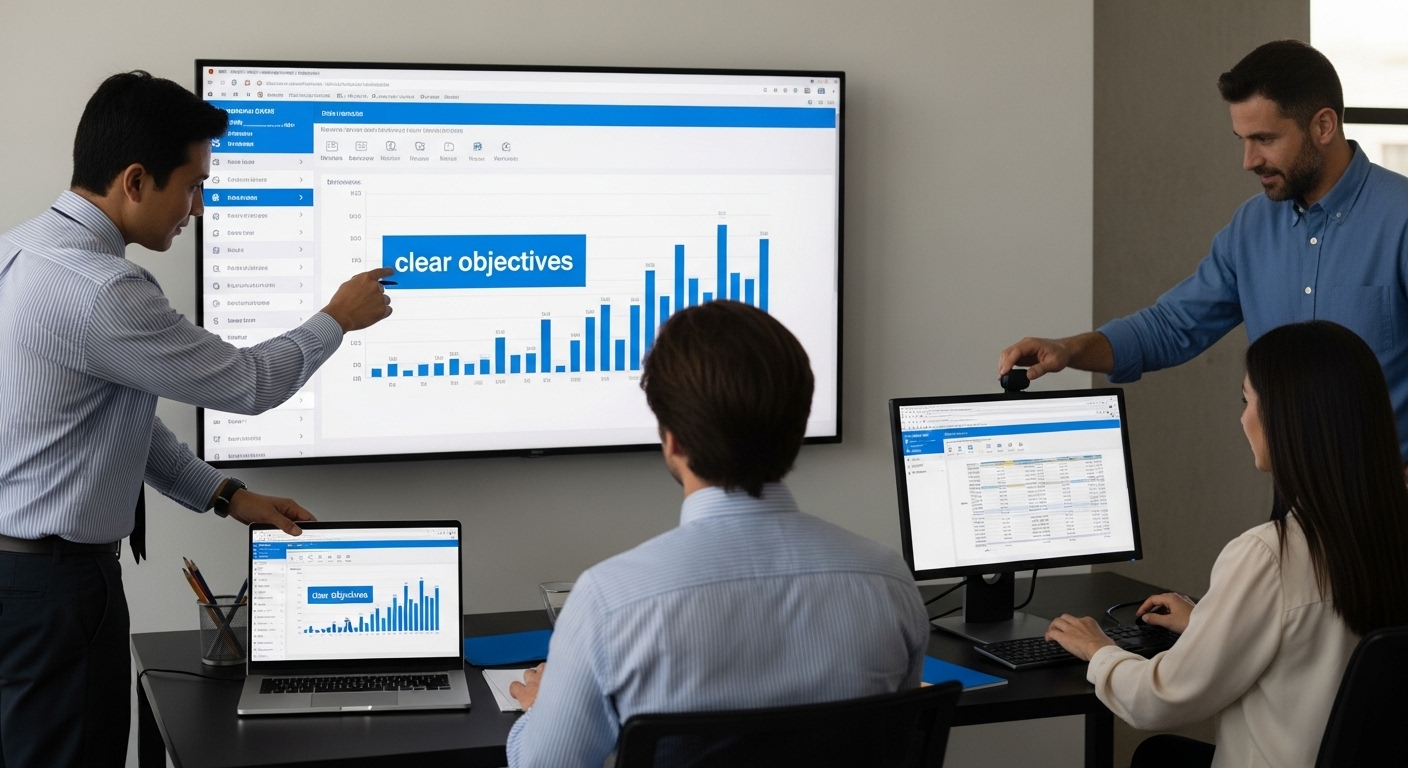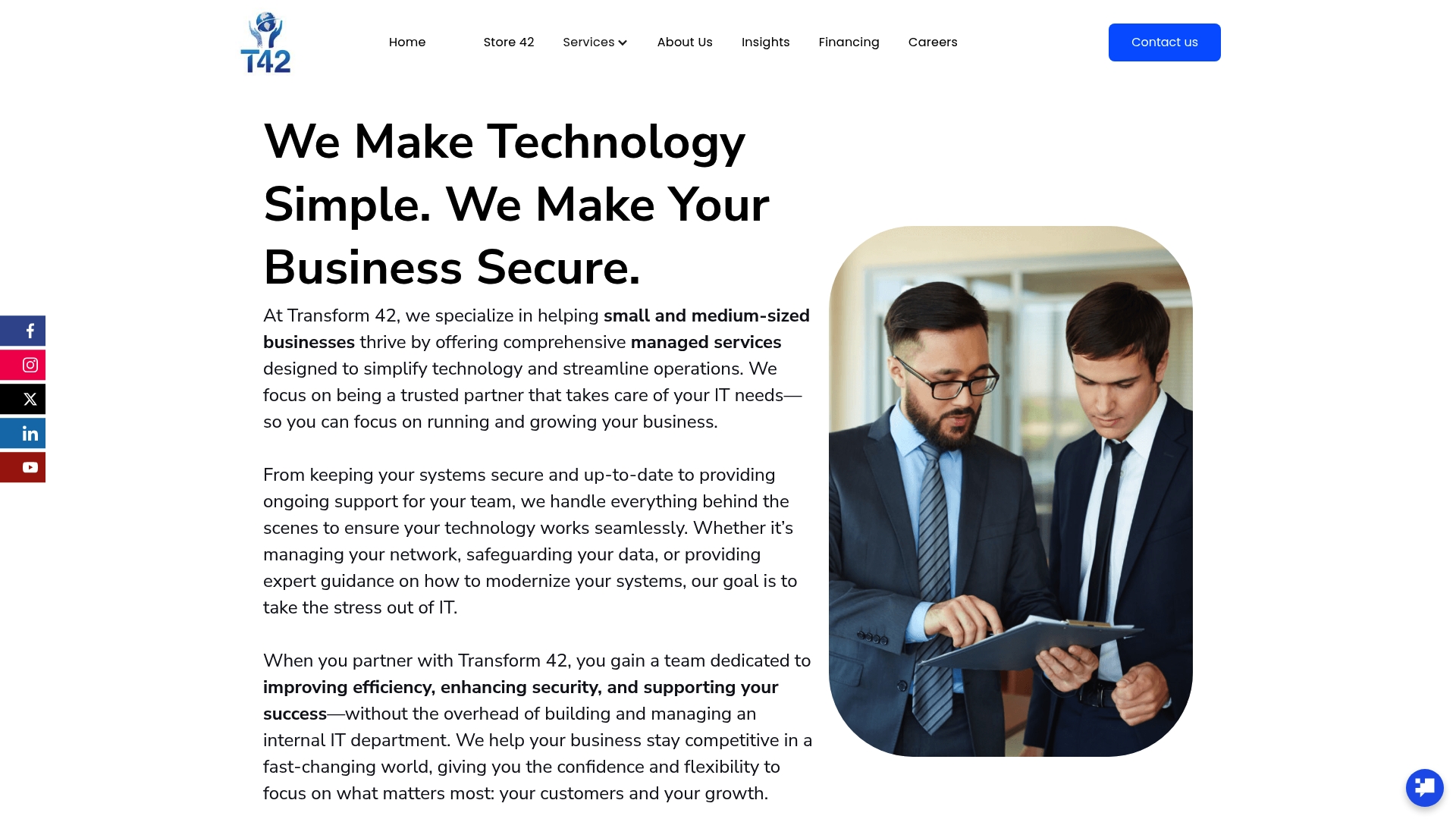
Accounting firms talk a lot about going digital, but most overlook the groundwork needed for real progress. Documenting your current systems will reveal roadblocks you had no idea existed and set the stage for breakthrough improvements. Numbers show that vague digital upgrades flop without a clear starting point—so the biggest wins come not from buying new software, but from deeply understanding the way your team already operates.
Key PointExplanation1. Assess current workflows and technologiesUnderstand your existing processes to identify areas for improvement. Document current systems to create a baseline for transformation.2. Define clear objectives and KPIsSet specific, measurable goals that address inefficiencies identified in assessments to guide your digital strategy.3. Select integrated digital toolsChoose software that aligns with operational needs and facilitates seamless integration between systems for optimal efficiency.4. Implement with a structured planCreate an implementation roadmap with timelines and training to ensure smooth transitions and reduce disruptions.5. Monitor progress continuouslyRegularly track performance against KPIs and adapt strategies to optimize the digital transformation process effectively.
Digital transformation for accountants starts with a comprehensive understanding of your existing operational landscape. This critical first step involves thoroughly mapping out your current technological infrastructure and workflow processes to identify opportunities for strategic improvement. Documenting your present systems and practices creates a baseline for meaningful digital evolution.

Begin by conducting a meticulous inventory of all current technologies, software platforms, and manual processes your accounting practice currently uses. Walk through each workflow systematically, from client onboarding to tax preparation and financial reporting. Pay special attention to areas experiencing frequent bottlenecks, redundant data entry, or manual interventions that consume significant time.
Below is a summary table of digital tools and software categories relevant for accountants, including their primary purpose based on the content mentioned above.
Tool CategoryMain PurposeClient communication & document managementStreamline client interactions and organize essential filesAccounting & bookkeeping softwareAutomate bookkeeping tasks and manage financial transactionsTax preparation platformsSupport compliance and accelerate tax-related workflowsTime tracking & billing toolsMeasure hours worked, manage invoicing, and track billable timeInternal collaboration & file sharingEnable secure team collaboration and efficient information flow
Key areas to examine during your assessment include:
Gather input from your entire team during this evaluation. Each team member will provide unique insights into process inefficiencies and technological limitations. Listen carefully to frontline experiences, as they often reveal hidden workflow challenges that management might overlook.
Learn more about strategic workflow optimization to understand how technology can streamline your accounting practice. By creating a detailed map of your current technological ecosystem, you establish a solid foundation for targeted digital transformation. This comprehensive assessment allows you to make informed decisions about which technologies to retain, modify, or replace in your upcoming digital evolution.
After mapping your current technological landscape, the next crucial step in digital transformation is establishing precise objectives and measurable performance indicators. This strategic planning phase transforms vague aspirations into concrete, actionable goals that will guide your entire digital workflow enhancement process.
Start by conducting a collaborative strategy session with your team where you articulate specific, measurable outcomes you want to achieve through digital transformation. These objectives should directly address the inefficiencies and pain points identified during your initial workflow assessment.

Consider goals that improve client service, increase operational efficiency, reduce manual workload, and enhance overall practice productivity.
When defining your key performance indicators (KPIs), focus on quantifiable metrics that provide clear evidence of progress. Effective KPIs transform abstract improvements into trackable numerical benchmarks. Some critical areas to measure include:
Ensure your objectives follow the SMART framework: Specific, Measurable, Achievable, Relevant, and Time-bound. For instance, instead of a vague goal like “improve efficiency,” create a precise target such as “reduce document processing time by 40% within six months using automated workflow tools.”
Explore strategic performance management techniques to refine your KPI development process. By establishing clear, measurable objectives, you create a roadmap that will guide your digital transformation journey, allowing you to track progress, make data-driven decisions, and demonstrate tangible value to your team and clients.
Choosing the right digital tools is a pivotal moment in your digital transformation journey. This step transforms your strategic objectives into tangible technological solutions that will reshape how your accounting practice operates. The goal is not simply to acquire new software, but to select integrated solutions that seamlessly align with your specific workflow requirements and performance targets.
Begin by conducting thorough research and comparing multiple software platforms that address the specific challenges and objectives you identified in previous steps. Look for solutions that offer robust integration capabilities, ensuring smooth communication between different systems. Cloud-based platforms that provide scalability, real-time collaboration, and advanced security features should be prioritized.
Consider tools that offer comprehensive functionality across multiple accounting domains:
During your selection process, request detailed demonstrations and trial periods from potential software providers. This hands-on approach allows your team to evaluate user experience, interface intuitiveness, and practical applicability to your specific accounting workflows. Pay close attention to how easily team members can adapt to the new technologies.
Explore advanced digital transformation strategies to refine your technology selection process. By carefully evaluating and selecting tools that genuinely enhance your operational capabilities, you create a solid technological foundation that will drive efficiency, accuracy, and growth in your accounting practice. Remember that successful digital transformation is about strategic alignment, not just acquiring the latest technology.
Implementing new technologies represents the critical juncture where your digital transformation strategy transitions from planning to execution. This step demands careful, methodical deployment to ensure smooth technological integration and minimal disruption to your accounting practice. Your implementation approach will determine the success of your digital workflow transformation.
Begin by developing a comprehensive implementation roadmap that outlines specific timelines, resource allocations, and milestone checkpoints. This roadmap should include phased rollout strategies, allowing gradual system adoption rather than abrupt, overwhelming changes. Start with pilot testing on a small team or specific workflow segment to identify potential challenges and refine your approach before full organizational deployment.
Key implementation considerations include:
During implementation, prioritize seamless data migration and system interoperability. Work closely with your software vendors to ensure smooth integration between different platforms, preventing data silos and maintaining consistent information flow. Careful attention to data security and compliance requirements is paramount during this transition.
Learn more about strategic digital transformation leadership to refine your implementation strategy. By approaching technological integration as a collaborative, adaptive process, you create an environment where new digital tools become powerful extensions of your team’s capabilities. Successful implementation transforms technology from a potential disruption into a strategic advantage for your accounting practice.
Training your team represents the critical human element of digital transformation, where technological potential meets practical implementation. Successful digital workflow adoption hinges on comprehensive, empathetic, and strategic skill development that transforms technological tools from intimidating interfaces into powerful productivity enablers.
Design a multi-tiered training approach that accommodates different learning styles and technological comfort levels within your team. Begin with foundational workshops that demystify new technologies, focusing on practical applications rather than technical complexities. Create interactive training sessions that combine theoretical instruction with hands-on practice, allowing team members to experiment and build confidence in a supportive environment.
Key training program elements include:
Establish a continuous learning culture where technology adoption is viewed as an opportunity for professional growth rather than a mandatory requirement. Encourage team members to share their experiences, challenges, and innovative uses of new digital tools. Designate internal technology champions who can provide peer-to-peer support and serve as approachable resources for colleagues navigating the digital transformation journey.
Explore leadership strategies for digital skill development to enhance your training approach. By investing in comprehensive, compassionate team education, you transform technological implementation from a potential source of stress into an empowering professional development opportunity that strengthens both individual capabilities and organizational effectiveness.
Monitoring and optimizing your digital transformation is not a one-time event but an ongoing, dynamic process that requires consistent attention and strategic adaptation. This critical step transforms your digital implementation from a static project into a living, evolving ecosystem of technological improvement. Your goal is to create a responsive framework that continuously measures performance, identifies opportunities, and drives incremental enhancements.
The table below outlines key optimization areas accountants should monitor during digital transformation, as described in the article.
Optimization AreaWhat to MonitorDesired OutcomeWorkflow bottlenecksSteps or stages that slow down workStreamlined, faster processesTime and cost savingsReduction in time spent and costsImproved efficiency and profitabilityUser adoption and satisfactionTeam engagement and feedbackHigher utilization and team buy-inTechnology integrationSystem compatibility and data flowSeamless information sharingReturn on digital investmentImpact of new tools on firm performanceQuantifiable value from technology
Establish a robust monitoring system that tracks the key performance indicators you defined earlier, using both quantitative metrics and qualitative feedback from your team. Regular review meetings should become a standard practice, where you analyze system performance, user experiences, and alignment with your original digital transformation objectives. These sessions are not about pointing out failures but constructively exploring opportunities for refinement and growth.
Critical optimization focus areas include:
Remain flexible and open to making strategic adjustments. Sometimes optimization means retiring a tool that isn’t delivering expected results or providing additional training to improve team proficiency. View each challenge as an opportunity to fine-tune your digital transformation strategy, creating a culture of continuous improvement that keeps your accounting practice at the forefront of technological efficiency.
Discover advanced strategies for workforce digital empowerment to enhance your optimization approach. By treating digital transformation as an iterative journey rather than a destination, you ensure your technological investments consistently deliver meaningful value to your accounting practice.
If inefficiencies, lingering manual tasks, compliance worries, or unreliable IT keep holding your firm back, it is time to bridge the gap between where you are and where you want your practice to be. You have just learned how mapping workflows, choosing the right tools, and building a resilient team culture can unlock new growth. Now bring that vision to life with real-world results. Our approach gives Miami accounting firms nonnegotiable reliability and ironclad compliance. That means you can experience 99.99 percent uptime, a guaranteed 15-minute response, and absolutely no unplanned downtime or regulatory penalties. Your peace of mind is not just a promise. It is backed by our money-back guarantee. Learn more about how we align IT strategies with your digital transformation goals.

Stop letting workflow bottlenecks and security risks slow you down. Stay ahead with nonstop support and seamless technology, tailored for accountants who want best-in-class results. Experience the relief and confidence that comes from working with a technology partner who stands by your success. Work with Miami’s trusted digital transformation leader and transform your firm today.
Digital transformation for accountants begins with assessing current workflows and technologies. This involves mapping out existing processes to identify inefficiencies and opportunities for improvement.
Establish clear objectives using the SMART framework (Specific, Measurable, Achievable, Relevant, Time-bound) to create actionable goals that address identified inefficiencies and improve overall performance.
When choosing digital tools, prioritize integration capabilities, scalability, user-friendliness, and comprehensive functionality across various accounting domains such as financial reporting, tax preparation, and document management.
Provide comprehensive training that accommodates different learning styles, establish ongoing support, create a culture of continuous learning, and incentivize technology mastery to encourage team members to embrace new tools.